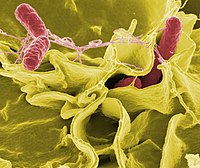
Photo from wikipedia
Multiple foodborne routes of Salmonella infection have been observed; however, the majority of the literature to date has been dominated by research into the most frequently observed reservoirs, such as… Click to show full abstract
Multiple foodborne routes of Salmonella infection have been observed; however, the majority of the literature to date has been dominated by research into the most frequently observed reservoirs, such as chicken, beef, and pork. While less commonly observed, outbreaks of Salmonella within sheep meat still occur, requiring extensive investigation by food safety inspectors. Risk assessment models inform policy makers and investigators of the risks posed by pathogens at each stage of the food chain, and help suggest at which stages in the food chain outbreaks are likely induced. This work is the first risk assessment into the prevalence of Salmonella throughout the sheep meat food chain, from farm to fork. A Bayesian evidence-synthesis model is used, informed by data gathered from 27 individual studies - an exhaustive search of the existing literature, to express and enumerate the current understanding of Salmonella prevalence in the sheep meat food chain in the form of probabilities of colonisation throughout the food chain. The resulting posterior estimate projects that 9 (0-29 95% HDI) UK individuals are likely to fall ill with salmonellosis due to sheep meat every year. A variance-based sensitivity analysis reveals that the abattoir module is the stage of greatest bacterial proliferation, highlighting it as the most probable source of outbreaks, though not to the exclusion of other factors.
Journal Title: Food microbiology
Year Published: 2022
Link to full text (if available)
Share on Social Media: Sign Up to like & get
recommendations!